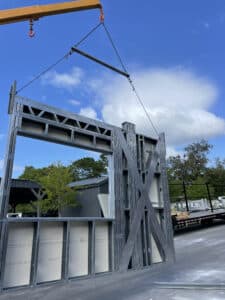The Benefits of Using Light Gauge Steel Framing in Sustainable Commercial Construction
Sustainability is no longer just a trend in construction—it’s an essential practice that developers, architects, and builders are adopting to reduce the environmental impact of their projects. Light Gauge Steel (LGS) framing plays a significant role in sustainable commercial construction, offering both environmental and economic benefits. From recyclability to energy efficiency, LGS framing supports the creation of eco-friendly commercial buildings. In this post, we’ll explore the ways LGS framing contributes to sustainability and why it’s a smart choice for developers committed to green building practices.
1. Recyclability and Resource Efficiency
One of the standout features of Light Gauge Steel is that it is 100% recyclable. Steel is one of the most recycled materials in the world, and using LGS framing in commercial construction reduces waste and supports sustainable resource management.
- Recyclable at Every Stage: From the manufacturing process to the end of a building’s lifecycle, steel can be recycled repeatedly without losing its quality or strength. This means that any leftover material from fabrication or demolition can be reused, reducing the environmental impact of construction.
- Sustainable Supply Chain: Many LGS products are made from recycled steel, further supporting a closed-loop supply chain. By choosing LGS framing, developers are not only reducing waste but also contributing to the demand for recycled materials, helping to minimize resource extraction.
The recyclability of steel makes LGS framing a highly sustainable option for commercial construction, reducing the environmental impact of new builds and renovations alike.
2. Energy Efficiency for Reduced Environmental Impact
Energy efficiency is a key factor in reducing the carbon footprint of commercial buildings. Light Gauge Steel framing supports energy-efficient designs by improving thermal performance and reducing energy consumption.
- Reduced Thermal Bridging: LGS framing systems are designed to minimize thermal bridging, which occurs when heat transfers through more conductive materials. By reducing heat transfer, LGS framing helps maintain stable indoor temperatures, reducing the energy required for heating and cooling.
- Compatible with High-Performance Insulation: Steel framing works seamlessly with modern insulation materials, further enhancing the building’s energy efficiency. Proper insulation around steel framing can significantly lower energy usage, resulting in reduced carbon emissions and energy costs.
By improving energy efficiency, LGS framing helps developers create commercial buildings that consume less energy and contribute less to greenhouse gas emissions.
3. Long-Term Durability for Sustainable Development
The long-term durability of Light Gauge Steel framing makes it a sustainable choice for commercial buildings, as it reduces the need for frequent repairs, replacements, or renovations.
- Resistant to Environmental Damage: Steel framing is impervious to common environmental threats like termites, mold, and moisture damage, which often lead to costly repairs in wood-framed buildings. By choosing LGS framing, developers can ensure that the building will last longer with fewer maintenance issues.
- Fire Resistance: Steel is non-combustible, which means it won’t catch fire or fuel the spread of flames. This makes it a safer option for commercial buildings and reduces the need for costly fire damage repairs, contributing to the building’s long-term sustainability.
The durability of LGS framing ensures that commercial buildings can withstand the test of time with minimal environmental and financial costs, making it a smart choice for developers looking to reduce their building’s environmental impact.
4. Supporting LEED and Green Building Certifications
Many commercial developers aim to achieve LEED (Leadership in Energy and Environmental Design) certification or other green building standards. Light Gauge Steel framing supports these sustainability goals by contributing to multiple aspects of eco-friendly construction.
- Recyclable Materials Credits: The use of recyclable materials like LGS framing can contribute to earning points in the Materials and Resources category of LEED certification, which rewards developers for using sustainable, recycled building materials.
- Energy Performance Credits: LGS framing helps improve energy efficiency, which can contribute to points in the Energy and Atmosphere category of LEED certification. Energy-efficient buildings not only consume less energy but also help reduce operational costs, benefiting both the environment and the building’s bottom line.
- Sustainable Construction Practices: The overall reduced waste and energy consumption associated with LGS framing can help developers achieve certifications in other green building programs, such as the Green Building Initiative or WELL Building Standard.
By using LGS framing, developers can support their green building certification efforts, helping to create more sustainable commercial properties that appeal to environmentally conscious tenants and investors.
5. Lower Carbon Footprint with Efficient Manufacturing
The production of Light Gauge Steel framing has become more energy-efficient in recent years, contributing to a lower carbon footprint compared to other construction materials.
- Energy-Efficient Steel Manufacturing: Many steel manufacturers have adopted cleaner, more energy-efficient technologies that reduce greenhouse gas emissions during the production process. This makes steel a more sustainable material from its very creation.
- Less Waste in Fabrication: The precision of prefabricated LGS components reduces material waste during production. This efficiency in manufacturing not only lowers the environmental impact but also saves developers money by reducing the need for excess materials.
The efficiency of modern steel manufacturing makes LGS framing a low-impact material choice for commercial construction, contributing to a greener building process.
6. Versatile Design Solutions for Sustainable Buildings
Light Gauge Steel framing offers a high degree of design flexibility, allowing developers and architects to create innovative, energy-efficient commercial buildings without compromising on sustainability.
- Customizable for Energy-Efficient Designs: LGS framing can be used to create energy-efficient building designs, including solar panel installations, green roofs, and other sustainable features. The versatility of steel ensures that developers can pursue creative solutions for reducing energy consumption and promoting sustainability.
- Supports Modern Building Techniques: LGS framing works well with modern building techniques, including prefabrication and modular construction, both of which are more sustainable methods of building. These techniques reduce on-site waste, minimize construction time, and promote resource efficiency.
The design flexibility of LGS framing supports the creation of eco-friendly, energy-efficient commercial buildings that meet modern sustainability standards.
Conclusion: LGS Framing as a Key Component of Sustainable Commercial Construction
For developers committed to reducing their environmental impact, Light Gauge Steel framing offers a practical and effective solution. With its recyclability, energy efficiency, long-term durability, and contribution to green building certifications, LGS framing is an essential material for sustainable commercial construction. By choosing LGS framing, developers can create buildings that not only meet the demands of today’s market but also contribute to a more sustainable future.
Contact Elite Steel Today! Ready to incorporate sustainable materials into your next commercial project? Contact Elite Steel at 1-904-799-6499 or visit elitesteel.com to learn more about how Light Gauge Steel framing can support your sustainability goals.


